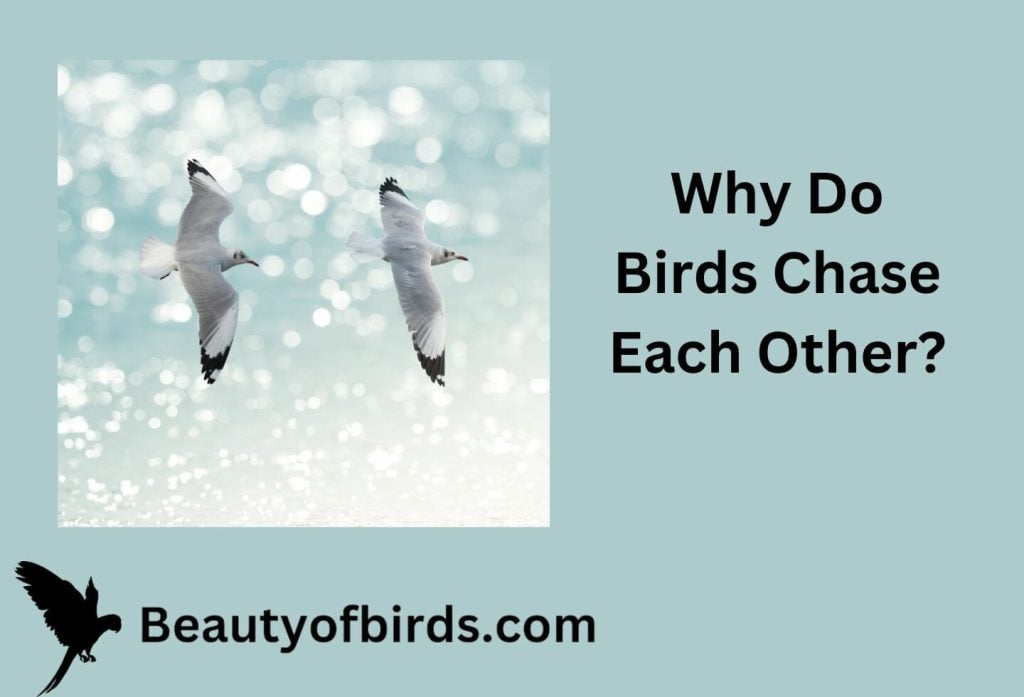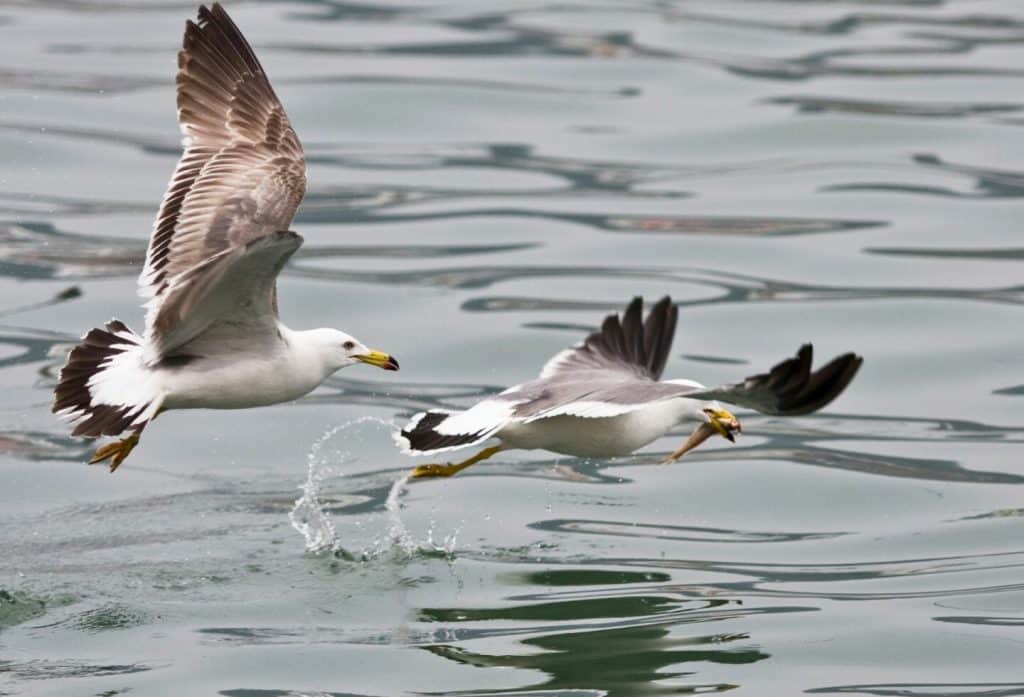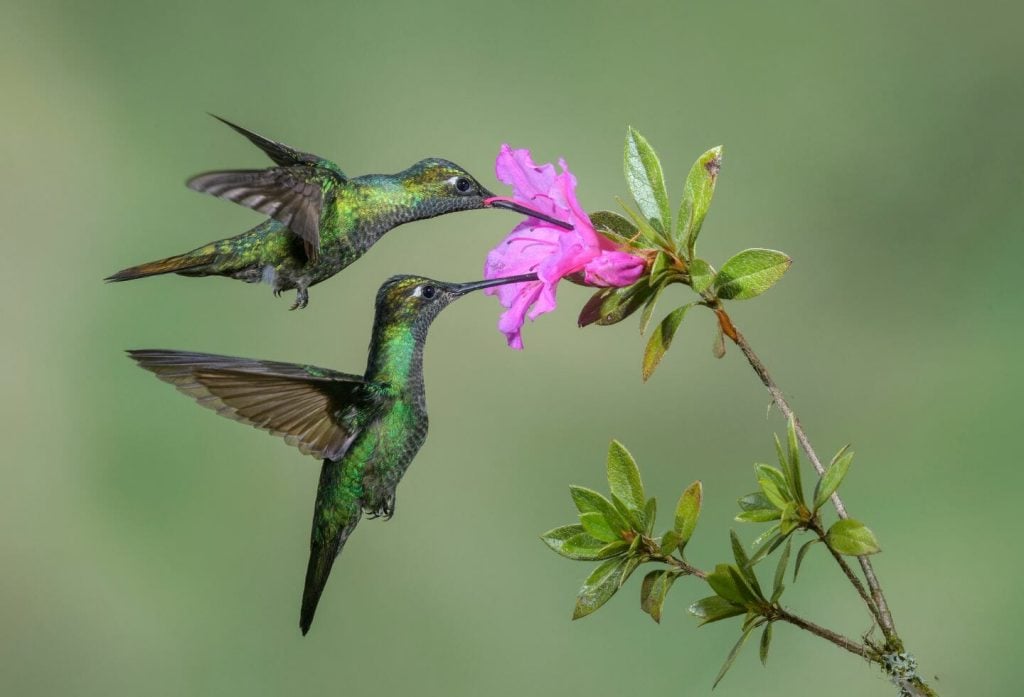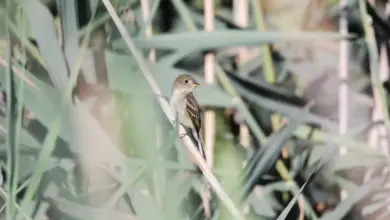Why Do Birds Chase Each Other: 7 Reasons
Why Do Birds Chase Each Other?
If you have ever noticed a flock of birds, you will often see some of them chasing others in mid-air, like miniature fighter jets on a battlefield – but what is this behavior all about? I will try to explore it below.
Birds are social creatures that often live in flocks in the forests. It’s not uncommon for birds to chase each other in the wild for various reasons.
When most people look at birds going after each other in this way, they assume that it is simply competition for food.
But there are other possible reasons as well – fighting for territory or even a mating ritual.
In the following article, I will discuss why birds chase each other.

Why Birds Chase Each Other
As I shared above, one of the most common reasons for chasing other birds is fights for food. But is that all there is to it?
It turns out that there are several reasons, and I will discuss them below.
Competition For Food
Well, it is no surprise that this reason is at the top of the article.
Food is important for everyone, including birds.
Many birds are opportunistic feeders; they will wait for others to find sources of food and then snatch it.
Others, who are more powerful, like to use their strength to monopolize their control over sources of food.
During the springtime, when sources of food are abundant, this is not so obvious.
But come winter, all of these behaviors become especially apparent since the sources of food become limited.
If birds see other birds with food, they will chase them to snatch the food.
Or if they see another bird trying to feed on a food source that they have discovered, they’ll aggressively chase it away.
In fact, you might have observed this behavior near your bird feeders as well – something that many bird lovers are all too well aware of.

Competition for food is often the main reason why birds chase each other
It is exactly why most put up multiple feeders at different places in their gardens.
This kind of competition is even more common among scavenger birds like seagulls and crows, whose source of food is further limited.
Some birds mark food territories and places to hide food.
If another bird were to find them out, the resident birds would become aggressive and chase it away to protect their food.
Aggression, protection, and monopolization are all an outcome of the primal survival instinct, and birds act in accordance with it.
Mating Rituals
Male birds, especially sparrows, pigeons, and doves, often chase members of the opposite sex to demonstrate their interest in mating.
In this sense, chasing is a kind of mating ritual as well as a show of strength and competence.
Male birds fly high in the air and compete to display their aerial acrobatics, which is a symbol of strength and vitality to attract a female bird for mating.
Since the female will finally decide who to mate with, the males try to put on their best show so they can be seen as potential mates.
Territorial Disputes
Birds can display territorial behavior if they think another bird is trying to enter their marked area. They will aggressively chase the outsider away.
Like any other living being, birds are fiercely protective of their nests and territory and will do anything to keep predators and intruders away.
Birds will often build a nest near food sources, and when another bird tries to enter their area, they will engage in aggressive behavior to chase the bird away.
Resident birds will not let anyone else use their food sources because that would mean less for them.
Pet birds also get territorial if you bring in a companion pet.
A new bird entering their territory can make your pet aggressive until it gets used to the company.
Asserting Dominance
Birds may chase each other in order to assert dominance. As we discussed, birds often move in flocks and often have an established hierarchy in these flocks.
Swans, geese, and ducks are observed doing this kind of chasing. They will chase each other until the dominant male establishes leadership within the flock.

Larger birds try to assert dominance over smaller ones in a flock
To Protect Their Chicks
Many birds have a strong parental instinct and will chase away any danger that might seem potentially harmful to their young.
Just like their territory, birds are also protective of their young.
If they sense predators or any kind of danger to their chicks, they will aggressively chase the intruder away.
Sparrows and robins often engage in this chase, driving potential threats away from their nests.
Play
Birds don’t always chase each other for serious reasons.
Sometimes, it’s simply playful behavior. Birds will fly after each other while playing, especially the younger ones.
For youngsters, this is a way to practice flying while also having a bit of fun.
Young chicks of birds like canaries and parakeets engage in this type of playful chase.
To Identify Threats
Survival instincts largely determine bird behavior. They’re always alert and looking out for threats and predators.
If they see an unfamiliar bird, especially in their territory, they will chase the bird to establish whether it is a threat.
Predator birds like hawks and eagles often engage in these kinds of chases.
They also often perch at higher altitudes to watch for threats. Owls are another bird that could engage in this type of chase.
Do All Birds Chase Each Other?
Not all birds will chase each other. Some chase only fellow birds of the same species, while others may only do so with other species.
The difference lies in the reason for chasing, among the ones I discussed above.
Birds of the same species may chase each other to attract potential mates, establish dominance within the flock, or practice their flying skills (mostly seen in young birds).
Others chase birds of other species because they are potential predators or are trying to feed from the same food sources as the former.
They may also chase them to scare them away and establish their dominance in a particular area.

Hummingbirds are notorious for chasing away other birds from feeders
Why Do Birds Fight Each Other?
Birds will often fight each other to protect their territory, nest, and food sources.
They are not always violent, so if you see them actively fighting with each other, it means something is wrong.
Either they don’t have enough space to co-exist peacefully, or there’s a dearth of food.
Bird fights can turn brutal very quickly because they use pecking and clawing to fight, which could seriously injure or kill the other bird.
You will often observe birds fighting on bird feeders. Specifically – the rufous hummingbirds and ruby-throated hummingbirds try to scare away other species.
Larger species of birds will try to monopolize the source of food and water by establishing a hierarchy through dominance and aggressive behavior.
Other times, subordinate birds make space for the dominant bird to feed by adopting a shy posture.
Wrap Up
Birds do things that humans find fascinating – after all, flying itself is something unique for us.
But perhaps the reason behind their actions is just as basic as anything that we would do.
Chasing each other is a behavior that many people ponder, but most of the time, the reasons are perfectly harmless.
They could be doing it while being playful or while practicing flying. Male birds chase each other to display their skills and strength in order to attract female mates.
But sometimes, birds chase each other for survival, like protecting their territories, nests, and food sources.
When this happens, it is often an indicator that food is scarce.
Thank you for reading!
Frequently Asked Questions
Why is my bird chasing the other?
When social birds that live in flocks or pairs do it, it could mean one of two things.
Firstly, they might be trying to establish dominance over the other bird or marking out their territory and showing the other bird who is the “boss.”
But it could just as easily be playful behavior, where the birds are simply enjoying each other’s company.
It is important to keep a check on the behavior of companion birds to make sure that it does not escalate into aggression or harm.
Provide them with enough space, food, and toys so that they don’t end up competing with each other.
How do you know if birds are fighting or mating?
During mating, birds engage in courtship behavior, such as singing and preening each other’s feathers as well.
They may also make soft cooing or chirping sounds.
On the other hand, during a fight, birds would flap their wings aggressively, squawk loudly, and peck or bite each other.
They may also puff up their feathers to appear larger and more intimidating. Parrots, in particular, like to pin their eyes to appear more threatening.
Keep a close watch, and you will be able to differentiate the two based on the other behaviors that the birds are showing.
Why do birds fight with each other?
Bird fights can become brutal quickly and cause serious injury or death.
Larger birds may establish dominance over food sources through aggressive behavior.
Smaller ones may adopt a shy posture to make space for dominant birds to feed.
What are the signs of aggression in birds?
Some common signs include:
Puffing feathers to appear bigger,
Lunging at people or other birds,
Biting or pecking,
Outstretched body and tail feathers,
Making loud and aggressive sounds, and
Flapping their wings aggressively.
When you see a bird showing these behaviors, try not to judge or punish it.
There’s likely some other reason that is causing the aggression – most of the time, it could be fear or changes in the environment.
Many times, there could be hormonal reasons as well, especially during the breeding season in late spring.



